Ryan Reynolds' 'Deadpool 2' Workout: The Push Day That Pumped Up His Arms
Here's the thing about celebrity fitness transformations. They're hardly doable for us mere mortals. You no doubt see Chris Hemsworth's arms in Thor: Love and Thunder, Jason Momoa's mammoth upper body in Aquaman 2, and Daniel Craig's trim physique (at the age of 51, no less) in No Time to Die and think, Yeah, I'd like to look like that. As we await the trailer for Deadpool 3 to drop, you can add another enviable body of work to that list: Ryan Reynolds. Thankfully, to make it at least moderately more attainable, we spoke to his trainer, Don Saladino, about how he helped the actor get in shape for each installment.
Saladino shared a Push Day routine he programmed for Reynolds to build three-dimensional muscle and fill out the iconic tactical suit—or as Reynolds likes to call it, Deadpool’s Big Red Body Condom??. It'll help you bulk up your own chest, shoulders, and triceps.
See the workout below and read on for Saladino's insight into how Reynolds has grown over their years of training together.
How to Complete Week 1 Push Day of Ryan Reynolds' Deadpool 2 Workout Program
Instructions
Perform 2 rounds of the A Block exercises with no rest between rounds.
Perform 5 rounds of the B Block exercise with 90 to 120 seconds rest between rounds.
Perform 4 rounds of the C Block exercise with 90 seconds rest between rounds.
Perform 4 rounds of the D Block exercise with 60 to 90 seconds rest between rounds.
Perform 3 rounds of the E Block exercises with 60 seconds rest between rounds.
Perform 3 rounds of the F Block exercise with 1-minute rest between rounds.
Note: Check out the full Deadpool 2 program and other workout programs designed by Saladino for Reynolds, Sebastian Stan, and more.
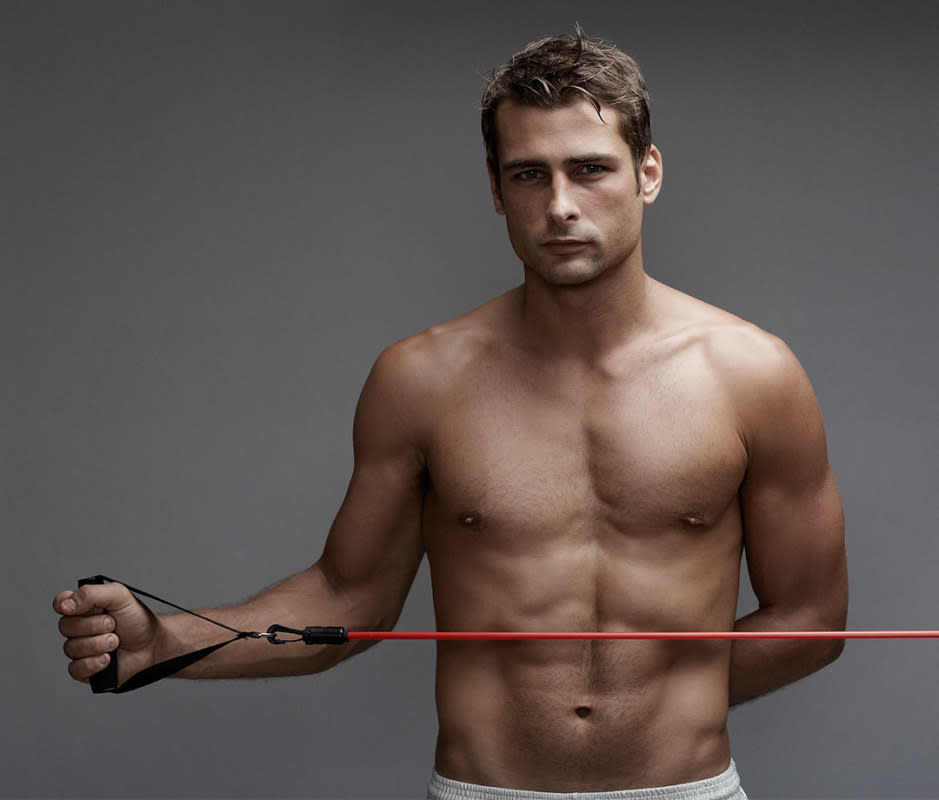
Fotosearch/Getty Images
How to Do It- Secure a light resistance band—or cable pulley with light weight—to an anchor point a few inches above your belly button. Optional: Have a folded hand towel handy to pin between your elbow and side, to start.
- Stand parallel to the band/cable and grab the handle of the resistance band with your far hand, elbow bent to 90, so the handle starts across your body, against your midline.
- Keep your elbow pinned to your side, and your wrist stiff and straight, as you rotate your forearm away from you as far as you can.
- With control, return to the start position. That's 1 rep. Complete all reps on one side, then switch.

Andrew Hetherington
How to Do It- Attach a rope handle to the top pulley of a cable station and grasp an end in each hand with palms facing you, to start.
- Pull the rope to your face, flaring your elbows out, thumbs pointing back, until your upper back is fully contracted.
- With control, return to the start position. That's 1 rep.
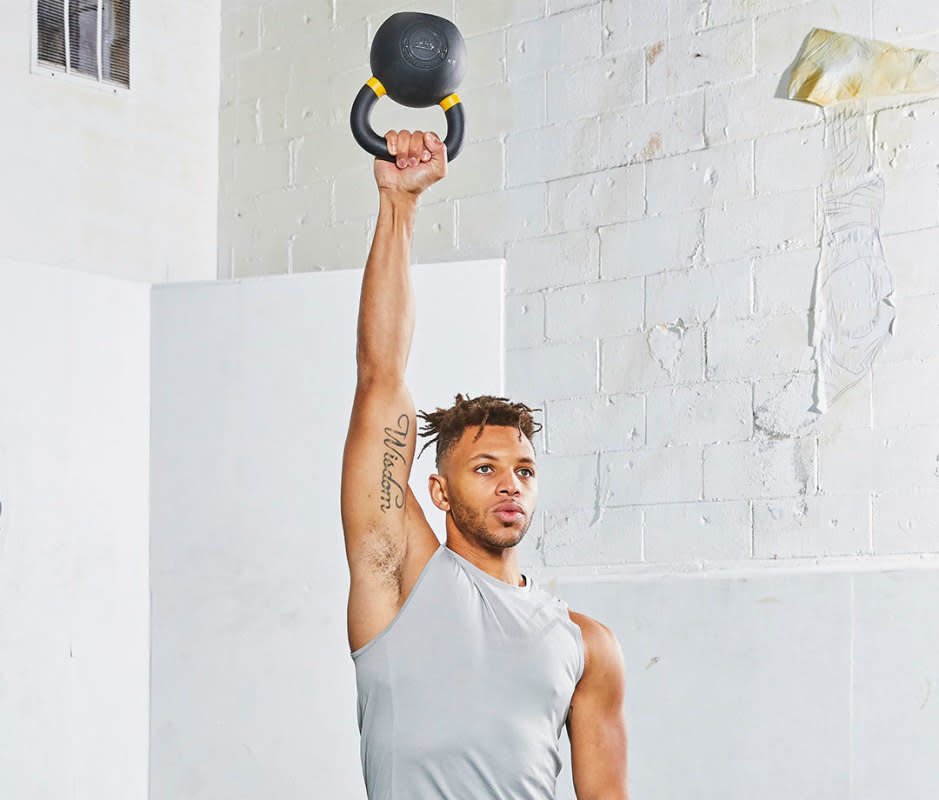
Marius Bugge
How to Do It- Stand tall with your feet shoulder-width apart, gripping a kettlebell in one hand by the handle. Use both hands to help position the kettlebell upside down, so the bell is pointing toward the ceiling, and rack it by your shoulder, to start.
- Keeping your wrist perfectly straight and the kettlebell steady, press your arm straight up, extending your elbow.
- Carefully bend your elbow and lower the kettlebell back to shoulder height. That's 1 rep. Complete all reps on one side, then switch.
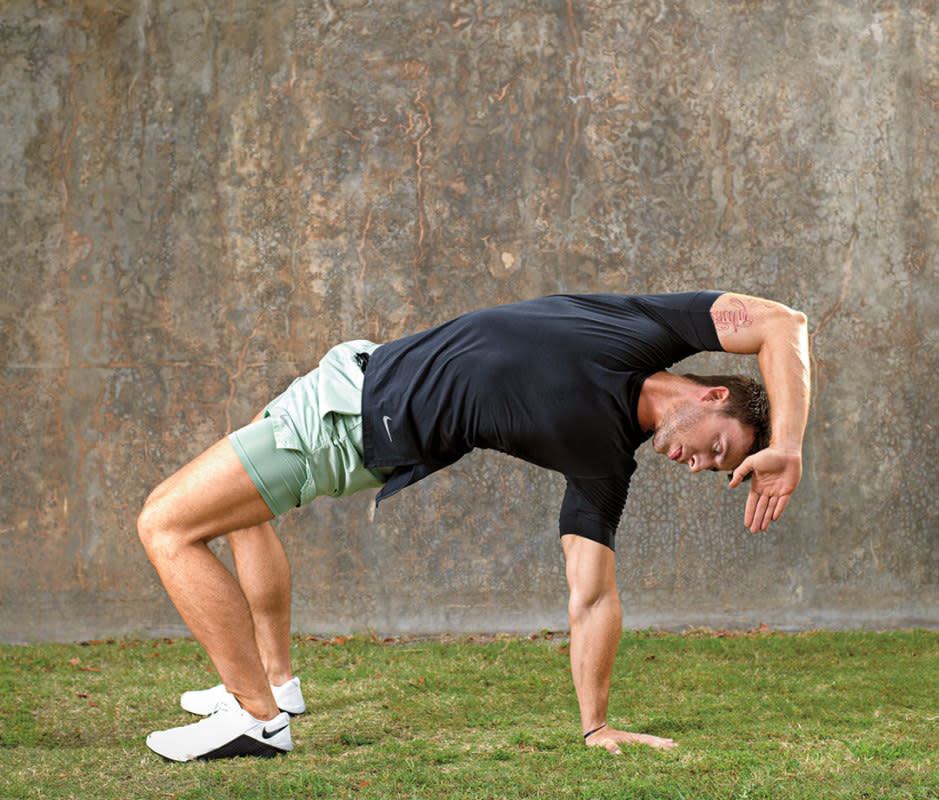
James Woodley
How to Do It- Start in a quadruped position, feet hip-distance apart, knees hovering 1 inch off ground, to start.
- Lift your right hand and left foot off the ground as you pivot on your right foot and drive your left knee through. Plant your left foot on the ground and drive through heels to extend hips up into a three-point stance bridge. Push your planted hand into the ground and drive your hips higher, engaging your glutes.
- Extend your right arm across your body, reaching to the left. For a deeper stretch, reach your arm up and over your head toward the opposite hand, keeping a soft bend in the elbow, eyes gazing at ground (shown).
- With control, return to the start position. That's 1 rep. Complete all reps on one side, then switch.
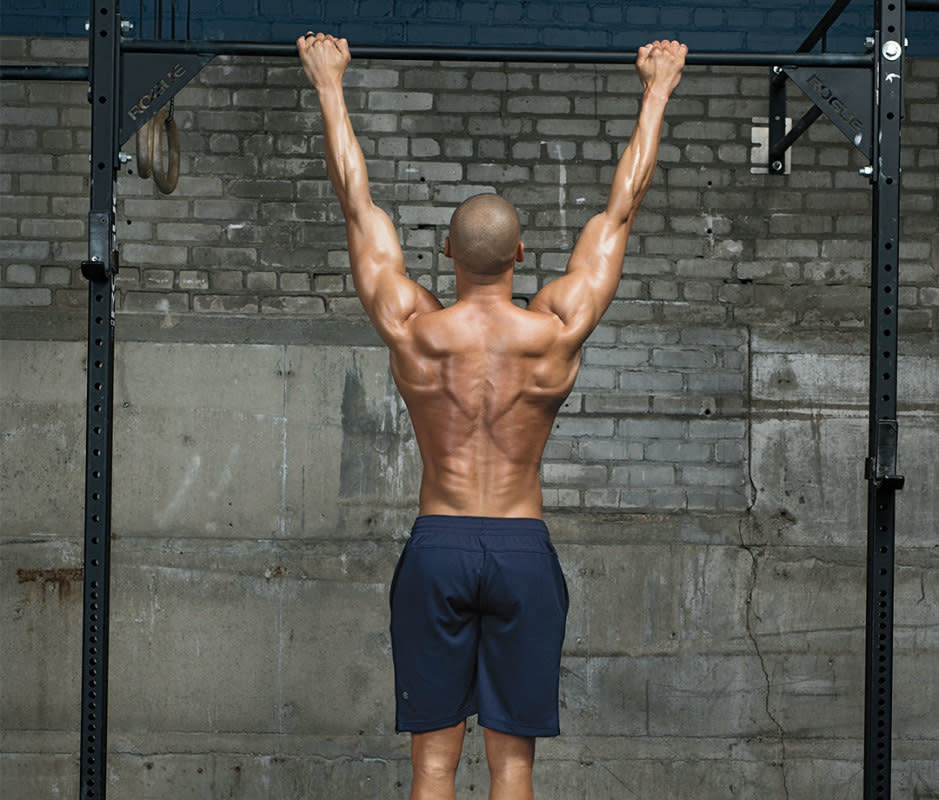
Dylan Coulter
How to Do It- If you're unable to reach a pullup bar from the ground, stand on a box and place hands on the bar using an overhand grip, to start.
- Step off the box, if using, and let your legs hang. Slightly tuck your pelvis under and think about drawing your ribcage down so it's not flaring out to keep your body in neutral alignment.
- Engage your core, glutes, and pull your shoulders down your back to engage your lats. Keep your eyes looking straight ahead. Hold while maintaining a strong grip.
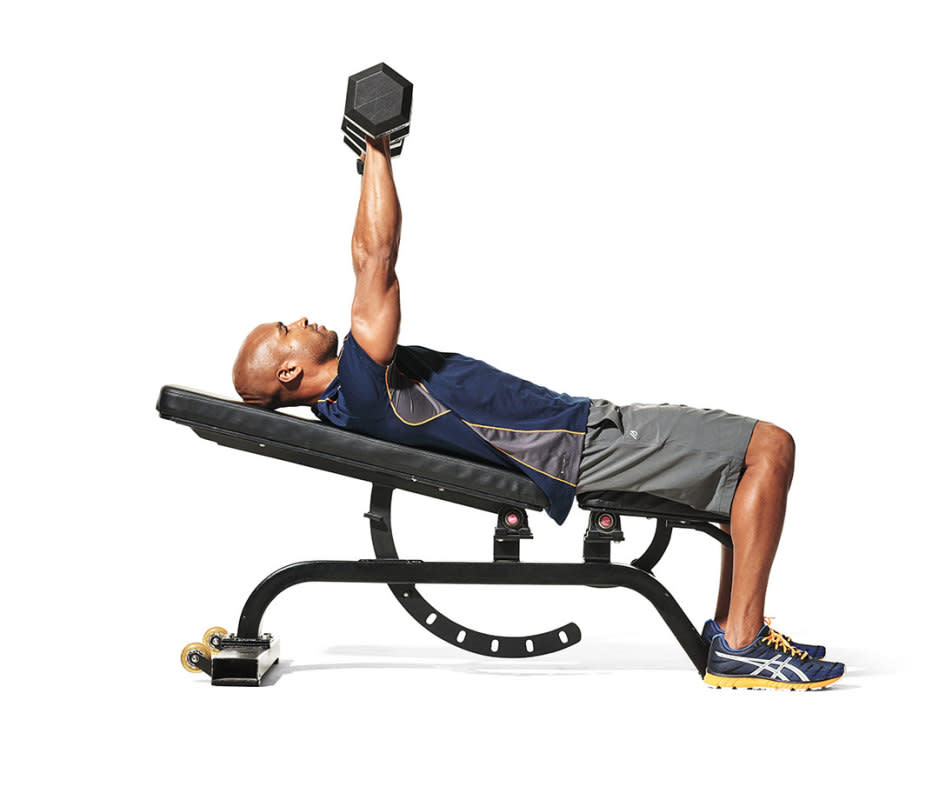
James Michelfelder
How to Do It- Set an adjustable bench to no higher than a 30-degree angle and lie back against it with a dumbbell in each hand or a loaded barbell at shoulder level, to start. Note: If you're just getting back into training or starting your fitness journey, start with dumbbells. Once you get stronger, advance to a barbell, which will add more size to your chest.
- Begin with the weight pressed over your chest. Follow a 3-0-1-0 tempo in which you lower the weight toward your chest for three seconds, don't pause, then press the weight up in one second, driving through your feet and exhaling at the top of the effort. That's 1 rep. Immediately descend into the next rep.
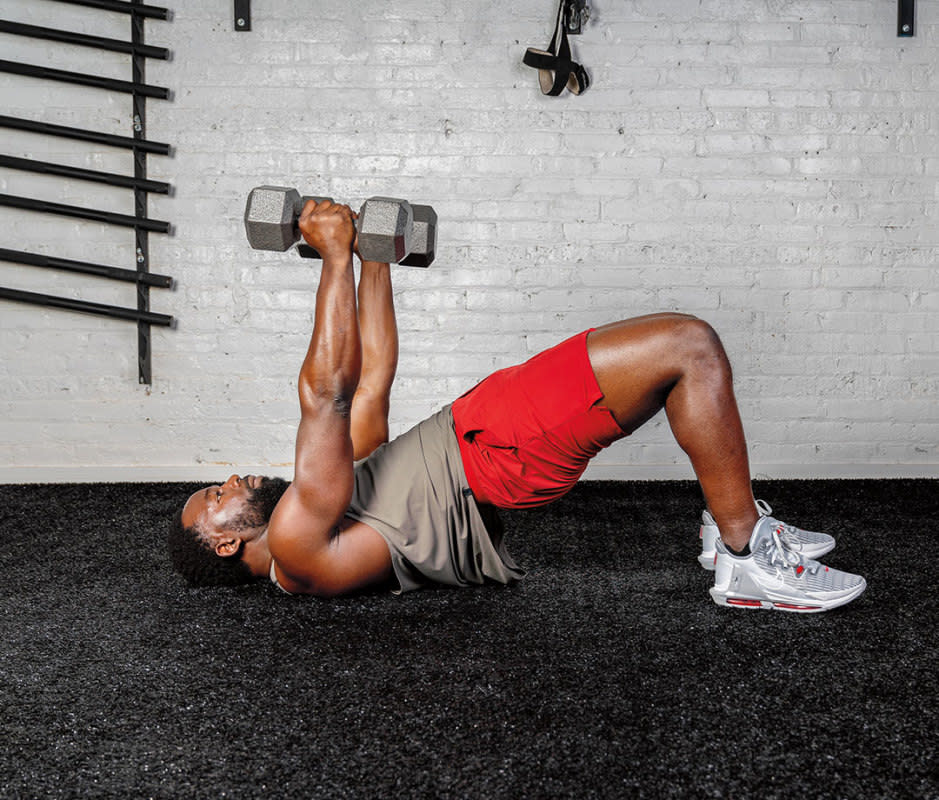
Andreas Endregaard
How to Do It- Note: Image depicts single-arm bridge floor press, which is a slightly easier variation of this exercise. Begin with this, then level up to the decline bench.
- Lie on a decline bench with knees bent at 90 degrees, feet hip-width apart, holding dumbbells in either hand, to start.
- Lift hips by driving heels into bench, engaging glutes. Position elbows out 45 degrees and stack wrists directly above.
- Exhale as you press dumbbells toward the ceiling, finishing with wrists directly over shoulders (shown). Inhale as you lower one weight to your outer ribs, then exhale to return to start position. Repeat on the other side. That's 1 rep. Alternate sides on each rep.
- Pro Tip: Really engage your core and glutes for stability; they’ll help keep your spine neutral and hips level and elevated for the duration of the round.
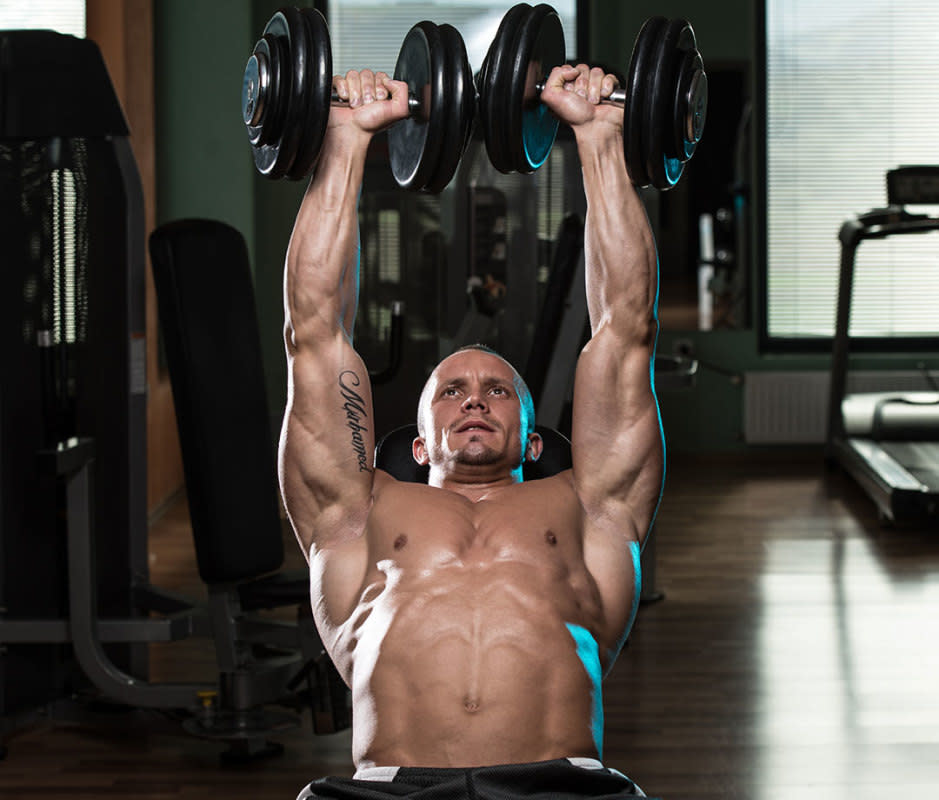
Ibrakovic/Getty Images
How to Do It- Set a bench to an incline of 45 degrees with dumbbells resting on top of your legs, to start.
- Sit back against the bench and kick your legs up to help drive the weights to your shoulders. Inhale, then press your feet into the floor as you drive the weights up toward the ceiling, exhaling at the top of the movement.
- With control, lower the weights to the start position. That's 1 rep.
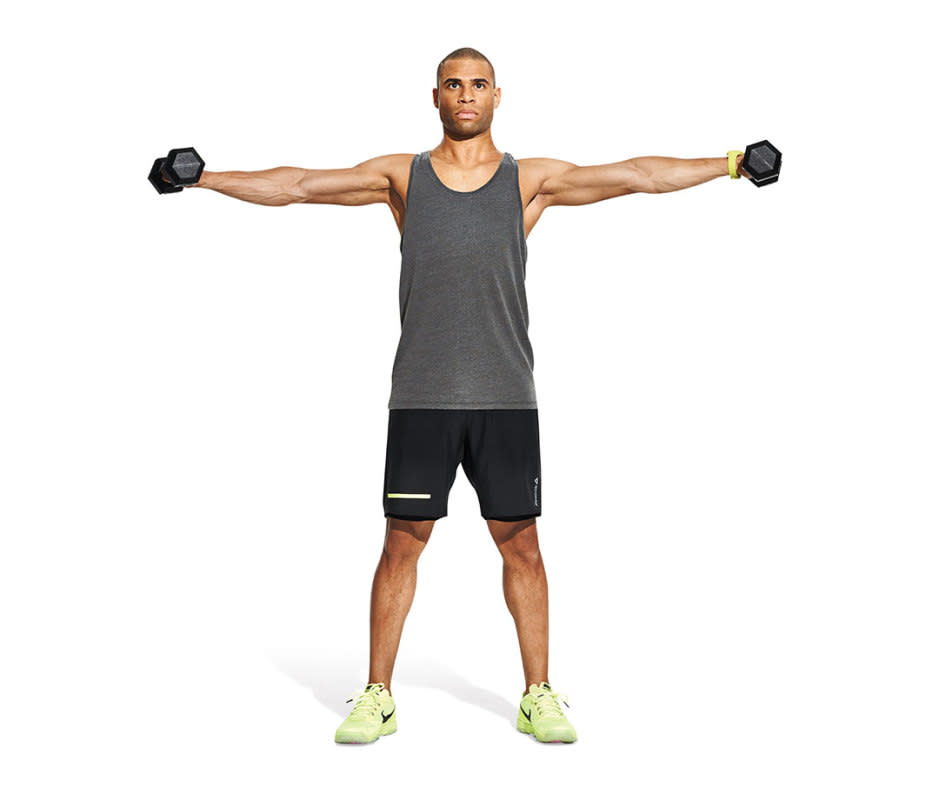
James Michelfelder
How to Do It- Stand with feet shoulder-width apart (or slightly narrower), and hold dumbbells at your sides, palms facing one another, to start.
- Raise the weights out 90 degrees to your sides.
- Lower your arms back to your sides while exhaling. That's 1 rep.
- Pro Tip: Don’t bend your elbows or swing your arms; the motion should be controlled and steady. If you need to start with lighter weights, do so.

Ian Maddox
How to Do It- Attach a D-handle to both cable pulley attachments at medium height, to start.
- Grab one in each hand and walk out a few feet so there’s tension in the cables.
- Keeping elbows up and slightly bent, fists parallel to shoulders, press hands around and forward to meet each other, like you’re hugging a tree.
- Reverse with control to the start position. That's 1 rep.
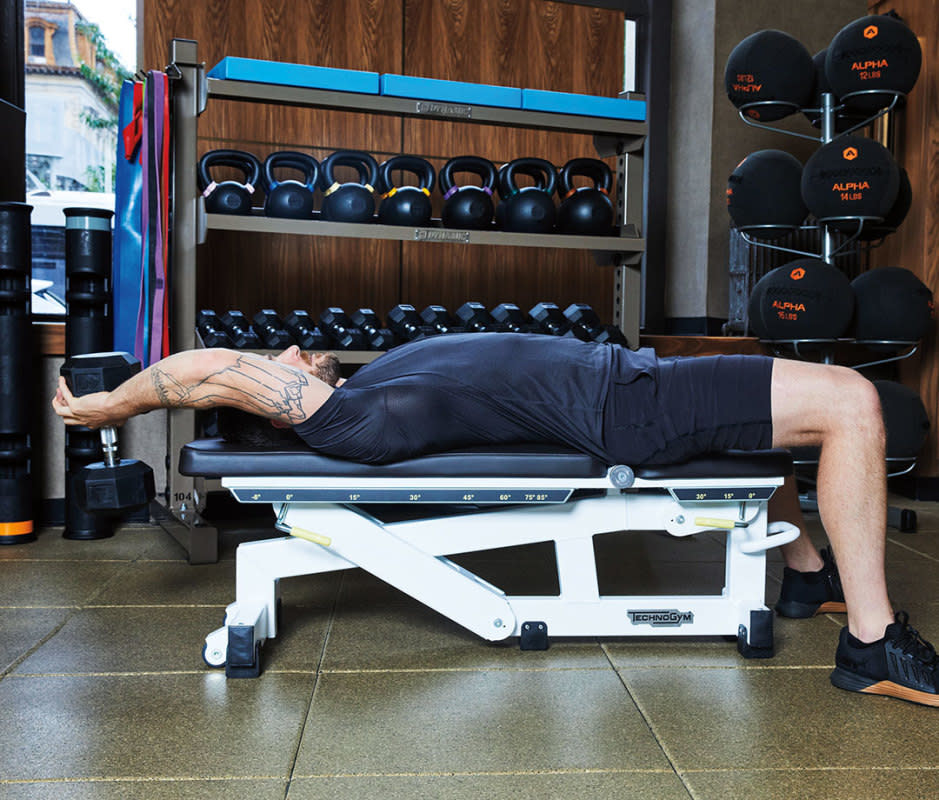
Marius Bugge
How to Do It- Lie faceup on a bench, feet flat on the floor, holding a dumbbell by one end, with arms straight overhead, to start.
- Bend elbows and engage triceps to bring dumbbell just behind head.
- Engage core and triceps to return to the start. That's 1 rep.
- Pro Tip: Make a diamond shape with your hands for the end of the dumbbell to rest in.

James Michelfelder
How to Do It- Attach a rope handle to a cable station at the highest setting, and hold an end in each hand, to start.
- Tuck your elbows to your sides and engage your core. Push down your elbows until they're almost fully extended, pushing the handle ends down and out away from your body.
- With control, return to the start position. That's 1 rep.
Men's Journal: Was there a difference in aesthetics or performance Reynolds needed to achieve going into Deadpool 2 and 3?
Don Saladino: I wouldn't say, aesthetically, we were looking at his physique saying, we need bigger shoulders or chest, or anything a bodybuilder would typically do. Training-wise the template changed a bit. He was someone who came from the body-part approach. Early on in his career, he loved coming in and crushing a body part with volume. There’s a time for that, but now we’re baking in doing touch-up work later in the week. If we’re training lower body early in the week, he might deadlift later in the week.
We tried to develop a lot of strength and resiliency in his glutes, hamstrings, and low back—throwing in a lot of posterior chain work. We’re always trying to get his glutes strong, because that ties into a strong foundation for him. Structurally, he has a really wide back and shoulders and a thin waistline, so appearance-wise he has a fantastic setup. Building glutes and hamstrings is something I put a lot of emphasis on to help his posture and how his body is feeling every day.
Related: 50 Best Leg Exercises for 2024
How did the training protocol change throughout the franchise?
On paper for the first Deadpool, the training split looked more like Day 1: Lower Body. [In Deadpool 2 and 3], we evolved to set things up with more frequency. You hit muscle groups again but lower volume. Sometimes as we age, adding all that volume can be really difficult. You get incredibly sore and it’s hammering your joints. You can stimulate hypertrophy, but it takes five days to recover and we’re not hitting it again. Ryan called me one day and said, I had some of the most grueling days on camera, but structurally I feel great. He’s tired, but his body feels good. Resiliency is my No. 1 focus. He’s gonna do as many things on his own that the production company allows him to do. Part of my job is giving him enough body armor to keep him functional. I need him to be athletic so if he’s sprinting around a corner, his body can withstand it.
View the original article to see embedded media.
How has Ryan surprised you over the years of training together?
The beautiful thing about Ryan’s fitness journey is he’s a self-sufficient person. He’s very open to having homework. He let his guard down and has complete trust in me. I think that's why we've always worked well together. He's really evolved with time and aging, where some people struggle to do that. We’re all getting older but that doesn’t mean we have to get worse. I've seen him evolve as an athlete. I've seen him evolve as a human. He's got four kids now. He's built billion-dollar companies. He's doing things from a charitable standpoint. He's got so much more on his plate to balance now.
Out of everyone I've ever worked with, Ryan and Blake, they're just on another level. What's more special about it is they're just such incredible people. Once you have that many things in your orbit that you're working on, it's so easy to be like, well, I'm not gonna put as much time into the mobility, the flexibility, the prehab, the behind-the-scenes work.
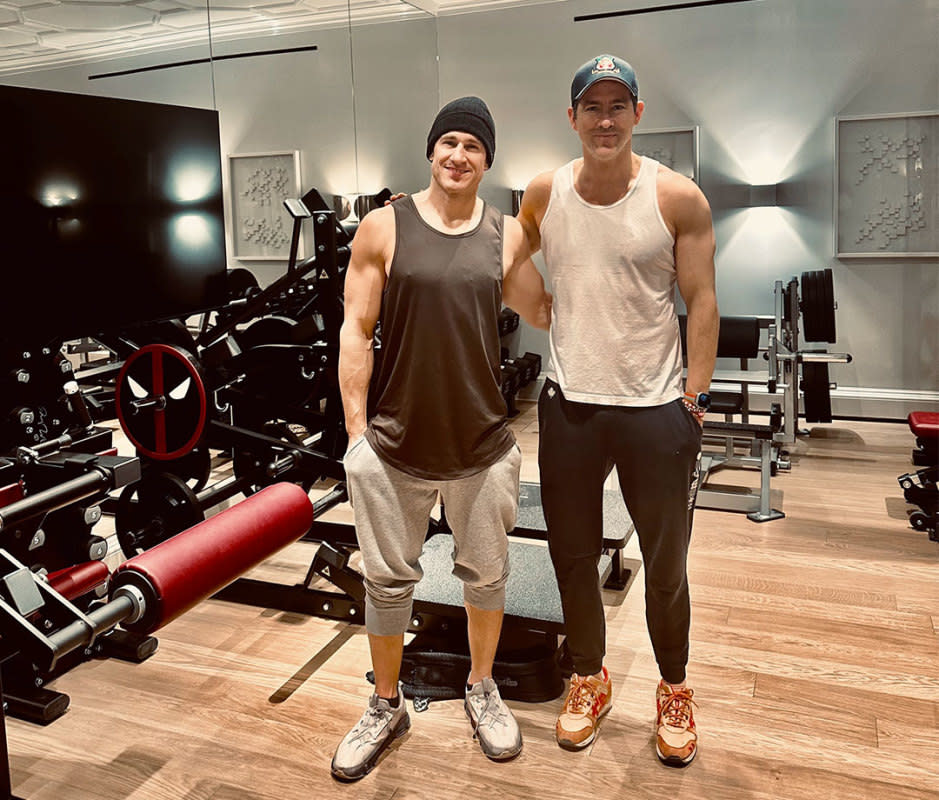
Courtesy of Don Saladino
Where did you have to make the most changes with his regimen?
Early on, he’d go very low carb and it would be really hard on him—his performance and energy. Then he started becoming more accepting of carbs and healthy fats and understanding the nutrition that has to go into our food. It can’t just be chicken and white rice. You’re hitting some of your macros, but it’s incomplete. His plate became a bit more colorful. The rest and recovery aspect—how he pays attention to his lifestyle—and small changes like if he has an appointment uptown, he’ll walk. He knows accumulating those steps is important.
What did he struggle with the most?
People have this no pain, no gain mentality. And the reality is that you might get in much better shape leaving a training session with some gas in the tank. You're not having an aneurysm when you're leaving? That’s a good thing. So I think he started learning that and he started trusting that process. I think that allowed him to recognize on days he feels great, it's time to put his foot on the gas.
Does he have unique strengths?
Very rarely do you see a guy at 6'2" who can do pullups the way he'll do 'em. He'll do multiple sets of 12 or 15, easily.
View the original article to see embedded media.
What would you say is the biggest misconception about training actors?
There's a big misconception on what people in Hollywood have to go through. These actors are doing stunts, they’re getting hurt on set. They’re flying to different time zones. There's so much volatility in their lifestyle and doing this while trying to manage family and other businesses.
People don't think about that and the stress on the body. Like the movie Ryan did with Will Ferrell called Spirited. He was dancing every day for like eight hours a day. You're not a ballerina. You're over 6’2” and 200 pounds. If you're not conditioned to do that, that becomes really taxing on the body.
I look at it like it’s a Formula One car. Every time that car pits, there are different problems that need to be addressed. The human body's no different.
